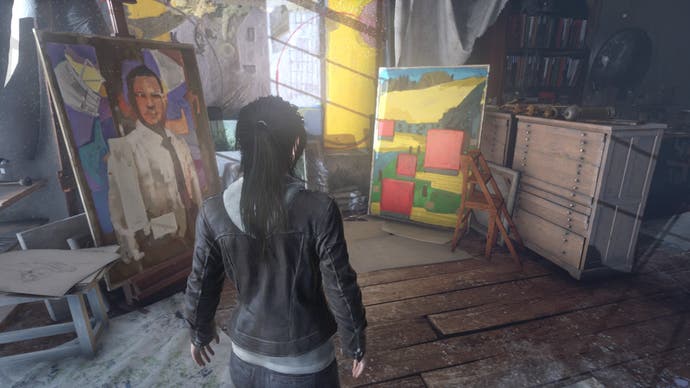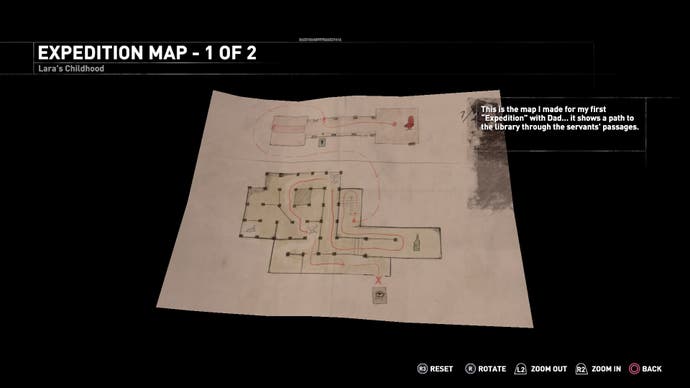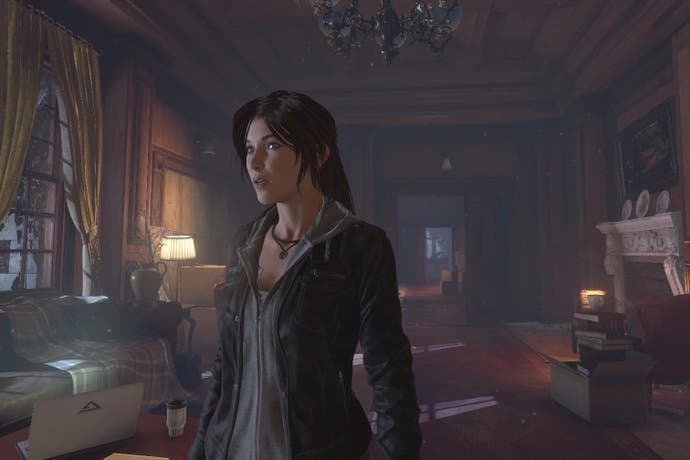Changing rooms: the shifting nature of Tomb Raider's Croft Manor
Blood Ties brings Lara Croft home.
The first house I ever owned was vast and elegant, a comfortable arrangement of grand halls and wide staircases with a treasure room glinting madly from the basement and a butler I enjoyed locking in the fridge. I would go back to that house to take a break from globe-trotting and jumping about in jungles - although, when I got there, jumping about was still pretty much all I did anyway. What a place: I loved it. You never forget your first home, and so I never forgot Croft Manor.
The manor's always been a core part of Tomb Raider's appeal, if you ask me, although I'm still only starting to understand why that is - particularly in the light of Rise of the Tomb Raider's delightfully odd DLC Blood Ties (included in the new PS4 edition of the game), which puts the old house firmly back at the center of things. To approach it in a different way, maybe the appeal of the manor has changed as the games have changed: as Lara Croft has evolved and been rebooted, and as the series has changed hands and different teams have tried to work out how to make Tomb Raider in a new image.
What I initially loved about the early Croft Manor was that its inclusion suggested that Lara Croft was bigger than the game she existed within. Away from the action, here was her home - introduced as a tutorial, sure, but quickly finding a purpose beyond that. Lara goes on adventures, right, but she also has an amazing house, much like Batman does, and why wouldn't you want to see that? And if you did see that, why not make it into a puzzle - albeit a very gentle kind - with secrets that you could uncover and nooks and crannies to explore? Why not make into a place that is suggestive of puzzles, so you never stop sounding it out?

I sometimes forget that Crystal Dynamics retained all this when it took control of the series with Tomb Raider: Legend, but it makes sense. Legend is one of the most thoughtful updatings of a video game that I can recall. What a game! It's Lara Croft not quite as you remember, but as you think you remember: the same sense of scale and emptiness to the environments, give or take the odd shoot-out and motorbike chase, and the same house waiting for her on the start menu, although it's been updated somewhat and filled with new members of the cast.
Crystal Dynamics would eventually blow the place to pieces, of course, sacrificing all that Tomb Raider history for a memorable opening to Underworld. I can see how that was hard to resist. Then the team would blow Tomb Raider itself to pieces, putting it back together again as a big-budget Everything Game where platforming had to compete with survival elements and cover-based shooting. No Croft Manor in the Tomb Raider reboot - and maybe it wouldn't really work with this Lara, who fell on spikes and got her ribs broken, who never did the mantling thing with the handstand, because, really, who would do that sort of thing when they were shipwrecked and terrified?
All of which makes the return of Croft Manor - if it's actually called that anymore - in Blood Ties a fascinating prospect. Blood Ties is fascinating in itself, in fact: a small, intricately built add-on that ties you to a single location. Lara is searching for evidence that will allow her to retain ownership of her family home but, as the story unfolds, she's really searching for an understanding of her parents: the mother who died too soon, the father who may have sacrificed everything for an insane quest. This narrative is treated with delicacy - the suggestion of the little ways in which women are often expected to put their ambitions aside sooner or later is wonderfully tart - and the manner in which it unfolds is really interesting. No traversal, survival, or shooting here. Instead you poke about a richly detailed country house, sifting through documents, reading into the backstory of the game, and occasionally stumbling upon a piece of equipment that opens up more of the floorplan.
It's almost an adventure game, and although it has problems - the clutter in the environment means you have to spam Lara's instinct vision, or whatever it's called, to highlight interactive elements - it still feels kind of laudable. I'm not entirely sure that Crystal Dynamics has got the full measure of its new version of Lara - or maybe I'm unsure that I'm personally keen on what they've turned her into - but it's nice to see that the search continues. We're looking for old documents and crowbars. Lara's looking for her parents. Maybe the developers are still looking for Lara.
And, inevitably, there are moments when this hunt falls apart. Alongside the core narrative here, in which the beats are quiet and largely internalised, there's a shooty nightmare mode in which you get to race through the place with a gun, blowing ghosts to pieces. It's not a disaster, by any means - nor is the VR mode which I've yet to properly mess around with - but it does feel like a failure of nerve, like a covering of bases. And this from a game which perhaps feels the need to cover too many bases already.

But what about the manor itself, though? It's largely a delight to be back, especially in a game that has such an interest in its own history, and such glorious art direction. It feels, in an odd way, a bit like returning to your home town after being away at university: that sense of being slightly invisible and out of sync, of being a ghost in your own world, your own timeline.
The place is a wreck, too: dust in the air, rain dripping in through the ceiling of the grand hall, doors locked or covered with piles of garbage. In amongst the dereliction you get nice little tableaux of domesticity: a four-bar heater propped up and sizzling in front of a boarded-off fireplace, a chess set with pieces scattered across an old kitchen table down in the basement.
There are plenty of callbacks to the old series throughout. I was particularly delighted with a note that mentioned how Lara used to lock the butler in the freezer. Sorry about that, Winston! And yet, for all the care and sense of legacy, this isn't quite my Croft Manor, because this isn't quite my Tomb Raider, and Blood Ties finally helped me to understand why not. That adventure game structure, gentle as it is in Blood Ties, still echoes the structure of the main Rise of the Tomb Raider campaign. Both are games in which you are constantly travelling with company - not in the form of an NPC perhaps, but in the form of a designer, who wants to trigger cutscenes and audio diaries and cinematics, who wants to point you in the right direction so you don't miss something crucial, and who wants to break a theoretically large environment into manageable pieces.
This is fine, of course, and a lot of people enjoy the hand-on-your-elbow kind of storytelling, the sense that you are being taken care of by a design team that doesn't want you to stop, to slow down, or to leave any treasure behind. And yet it's not Tomb Raider as I remember it: Tomb Raider that was sometimes awkward and badly signposted, that would leave me for maddening hours on end exploring a vast location looking for a tiny key that was hidden on a piece of carpet somewhere, say, or a lever that I had simply forgotten to trigger.
Tomb Raider used to be a lonely game about exploring vast places and trying to work out what their purpose might be. That was true for the campaigns and, in its compacted, playful, open-ended way, it was also true of Croft Manor, with that treasure room waiting for you if you wanted to find it - hidden away, but not exactly calling out to be discovered.



.png?width=291&height=164&fit=crop&quality=80&format=jpg&auto=webp)












